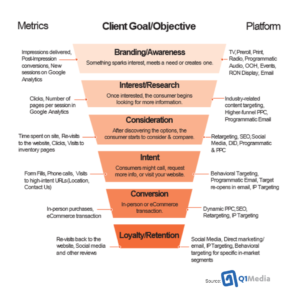Your database is a valuable tool that can help you optimize customer visits, but did you know you can also use it to optimize your media plan and reach your target audience more effectively? By leveraging the data you have on hand, you can make informed decisions about where to allocate your resources and how to craft your messaging for maximum impact. Today, we will explore some of the key strategies you can use to unlock the full potential of your database and take your media plan to the next level.
As competition for leisure dollars continues to expand, it becomes increasingly essential for casino marketers to focus on the best strategies that will lead to successful advertising campaigns. While many may think the message is the most critical part of advertising, media planning — researching, selecting and implementing advertising channels to best reach and communicate with target audiences — can make or break that message. Effective media planning plays a vital role in driving traffic, increasing revenue and building brand awareness in the casino industry. By targeting the right platform and audience, marketers can position their casinos as ideal destinations for players, ultimately leading to more loyal customers and a more substantial reputation in the industry. Effective media planning can make all the difference for casino marketers looking to stand out in a crowded market.
But with so many options available, the media planning process can feel like spinning a roulette wheel. However, the ongoing transformation of media channels to highly targeted and trackable platforms makes utilizing the information in our databases a match made in heaven.
Traditional Database Utilization
Casino marketers have long relied on databases to improve their marketing efforts. With the vast amounts of data collected on players, casinos can segment their database to create targeted direct marketing campaigns that resonate with their customers. By identifying trends in their data, casino marketers can make data-driven decisions that can significantly impact the success of these campaigns. For example, analyzing the frequency of visits and average spend per visit can lead to more relevant offers and promotions being sent to customers. Additionally, casinos can analyze player behavior to determine which games and amenities are most popular, allowing them to tailor their marketing strategy accordingly. With the power of databases, casino marketers can create personalized experiences that keep customers returning for more.
A typical casino database will include customer demographics (e.g., age, gender, location), playing behavior (e.g., frequency of visits, the amount spent), and perhaps preferences (e.g., preferred games, amenities, etc.).
Casino marketers leverage data to develop near-one-to-one, high-impact campaigns that drive customer engagement and revenue. For example, they may uncover VIPs who last visited a while ago. By crafting special incentives designed just for them, the property can create a reason to reach out and invite them in for additional visits, ensuring maximum return on marketing investments by turning consumer insights into powerful strategies.
Expanding the Utilization of Data
The information commonly found in casino databases can inform media planning in several ways. For example, demographic data such as age, gender, and location can help casino marketers determine which media channels are most likely to reach their target audience. Suppose the data shows many customers are in a specific age range or location. In that case, marketers can use that information to choose media channels more likely to resonate with a lookalike audience. Similarly, customer behavior and preferences data can help marketers create more relevant and personalized advertising messages that are more likely to resonate with specific customer segments. For example, if a segment of customers tends to play a particular type of game, marketers can create ads that focus on that game to increase engagement.
Casino databases are a valuable resource for media planners, allowing them to customize their campaigns and tailor messaging accordingly. By leveraging demographic data like age, gender and location of customers, marketers can hone in on which channels will be the most successful at reaching intended audiences. With greater insight into audience preferences within specified variables such as age range or geography comes more effective strategies that effectively use marketing budgets while still delivering impactful results.
Combining traditional and newer media channels can help casino marketers reach their target audience more effectively and efficiently, driving engagement and revenue.
Combining traditional and newer media channels can help casino marketers reach their target audience more effectively and efficiently, driving engagement and revenue. Newer media channels that are highly targetable can be particularly effective when used with the knowledge found in a database. For example, social media advertising can effectively reach specific demographic segments, such as younger audiences on TikTok or Boomers on Facebook. Social media platforms allow marketers to target users based on demographic and behavioral data, such as interests, hobbies, and online behavior. This can be particularly useful for promoting specific casino events or promotions to relevant segments. Similarly, programmatic advertising can be highly effective for reaching specific audiences at scale, using data to target users based on a wide range of criteria such as location, interests, and behavior.
Why Segmenting the Casino Database is Important for Media Planning
Segmenting the casino database is an essential step in media planning. Segmenting the database based on demographics, playing behavior, and customer preferences can help inform media planning decisions and drive marketing success. Marketers can create more targeted and effective advertising campaigns that drive customer engagement and revenue by dividing the database into specific groups based on relevant criteria.
Ways to Segment the Database
There are several ways to segment the casino database. One of the most common ways is demographics, such as age, gender, and location. This can be particularly useful for determining which media channels are most likely to reach specific demographic segments. For example, suppose many customers are located in a particular geographic region. In that case, marketers can focus their advertising efforts on popular media channels in that region.
Another way to segment the database is by playing behavior. This can include metrics such as frequency of visits, the amount spent, and the types of games played. By segmenting the database based on playing behavior, marketers can create more targeted advertising campaigns focusing on specific games or promotions likely to appeal to particular customer segments.
Segmentation can also be based on customer preferences, such as preferred amenities or entertainment options. For example, if a segment of customers tends to visit the casino primarily for its restaurants and entertainment offerings, then marketers can create ads that focus on those amenities.
Examples of How Segmentation Can Inform Media Planning Decisions
Segmentation can inform media planning decisions in a variety of ways. For example, suppose demographic data shows that many customers are active on social media. In that case, marketers can prioritize social media advertising over traditional media channels like TV or print. Similarly, suppose segmentation based on playing behavior shows that a particular game is popular among a specific customer segment. In that case, marketers can create ads highlighting that game to increase engagement. Suppose segmentation based on customer preferences shows that a particular amenity or entertainment offering is popular among a specific customer segment. In that case, marketers can create ads focusing on those amenities to drive engagement. Segmentation based on location can also aid in targeting specific areas or points of interest.
Finally, segmentation can help marketers measure the effectiveness of their marketing campaigns more accurately. By tracking the behavior of specific customer segments, marketers can determine which campaigns are most effective and refine their strategies accordingly.
Digital advertising strategies have revolutionized how businesses market themselves, giving them powerful tools to track customer behavior and achieve more significant ROI. Once you have implemented your media plan, measuring and optimizing your results is essential. Use your database to track key metrics such as website traffic, engagement, and conversion rates. This will help you identify which channels and tactics are working well and which need improvement. This information lets you adjust your media plan to optimize its effectiveness. For example, your social media ads generate a high click-through rate but a low conversion rate. In that case, you should adjust your targeting or messaging to align with your audience’s needs and preferences.
One of the most valuable features of digital advertising is the ability to track viewers of an ad if they enter your business. This is accomplished through geolocation technology, which allows casinos to identify the physical location of a customer’s device based on their IP address. By tracking the location of devices that have viewed an ad, businesses can gain valuable insights into customer behavior and use this data to optimize their marketing efforts. This level of precision targeting helps casino operators see greater returns on their advertising investment and improve overall customer satisfaction with messaging.
Marketing Funnel
 The marketing funnel is used by businesses across a wide range of industries and sectors, including B2B and B2C businesses. However, it is most commonly associated with consumer marketing for products and services. Some of the most common types of companies using the marketing funnel include e-commerce, retail stores, restaurants, and consumer packaged goods companies. These types of businesses typically have a large customer base and are highly focused on attracting and retaining customers through targeted marketing efforts. The marketing funnel provides a useful framework for understanding the customer journey and creating customized marketing strategies for each stage of that journey. Although not commonly used in the casino, the concept can be valuable to casino marketers.
The marketing funnel is used by businesses across a wide range of industries and sectors, including B2B and B2C businesses. However, it is most commonly associated with consumer marketing for products and services. Some of the most common types of companies using the marketing funnel include e-commerce, retail stores, restaurants, and consumer packaged goods companies. These types of businesses typically have a large customer base and are highly focused on attracting and retaining customers through targeted marketing efforts. The marketing funnel provides a useful framework for understanding the customer journey and creating customized marketing strategies for each stage of that journey. Although not commonly used in the casino, the concept can be valuable to casino marketers.The framework visualized the journey that customers take from initial awareness to final purchase – in the case of a casino, to a visit with play. It breaks this journey into several stages, typically including awareness, consideration, and decision. By understanding where customers are in the funnel at any given time, casinos can tailor their marketing messages and choose appropriate channels to reach those customers. For example, a target customer in the awareness stage may respond well to an ad on social media. In contrast, a potential customer in the decision stage may need more information before visiting. By understanding the marketing funnel, casino marketers can create messages and choose channels that are most appropriate for the given stage of the customer journey, thereby improving the effectiveness of their marketing efforts.
Using your database as a foundation and continuously measuring and optimizing your results, you can ensure that your media plan delivers the best possible ROI.
Summary




Recent Comments